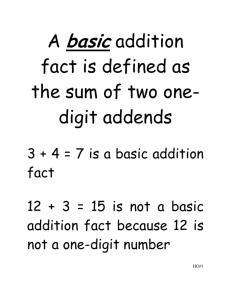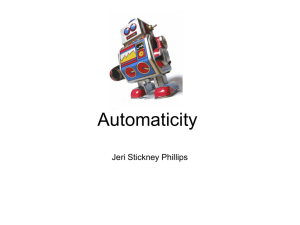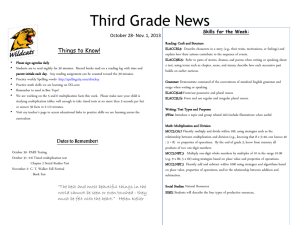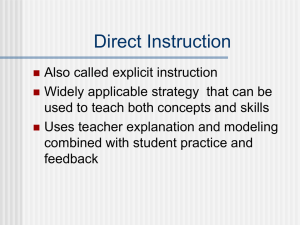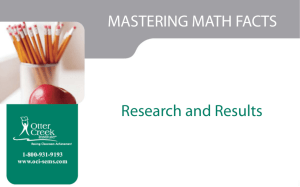Doug_Dissertation Summary and Critique
advertisement
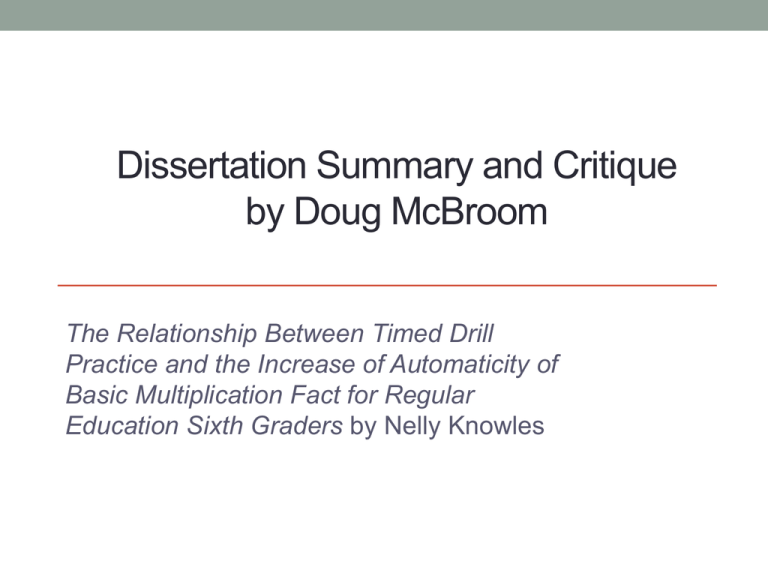
Dissertation Summary and Critique by Doug McBroom The Relationship Between Timed Drill Practice and the Increase of Automaticity of Basic Multiplication Fact for Regular Education Sixth Graders by Nelly Knowles General Information • Knowles study was about automaticity which is the automatic recall of facts once learned (math, science, history, etc.) • Framework came from the use of Piaget’s cognitive development theory • The mental model used is from Baddely’s working memory model • Quasi-experimental quantitative study Research Questions • Do written, timed practice drills increase automaticity in basic multiplication facts for sixth-grade math students? and • Does frequency of written, times practice drills significantly change the automaticity rate in basic multiplication facts for sixth-grade math students? Demographics • Knowles conducted this study in a middle school outside • • • • • of Atlanta, GA. There were 227 students chosen from the school in regular math classes. No information about the teachers was given. No breakdown of students by gender, ethnicity, etc. School had a 96% attendance rate Of the sixth grade class, 92.4% met or exceeded the standards of the 5th grade math test. General Summary of the Study Purpose • Knowles framework uses Piaget’s concrete operational stage for middle school students. • Baddeley’s working memory model states that people have processing resources that are limited. • Knowles uses these two idea to propose that since students have the ability to remember automatically, it will “free up” the limited capacity of students to work on the topic at hand rather than computational mathematics. Hypotheses • H0 – Use of written, times practice drills will not be significantly associated to a change in the automaticity rate in basic multiplication facts for six-grade math students • H1 - Use of written, times practice drills will be significantly associated to a change in the automaticity rate in basic multiplication facts for six-grade math students • H0 – Frequency of use of written, timed practice drills will not be significantly associated to a change in automaticity rate in basic multiplication facts for sixth-grade math students • H1 - Frequency of use of written, timed practice drills will be significantly associated to a change in automaticity rate in basic multiplication facts for sixth-grade math students What happened in the Study? • Students were divided into three groups and three subgroups (1 of each group for each teacher) • Students were given two pretests and one posttest. • For eight weeks, students were given 1) daily written timed tests, 2) weekly written timed tests, or 3) no written timed tests. Tests were three minutes in duration. • Analysis was done of the data collected Findings • Found no significant difference in pretest scores • Found that the daily treatment group had a higher gain score than the weekly treatment and the no treatment groups • The weekly treatment group had a higher gain score than the no treatment group Limitations and Future Recommendations Limitations • Study was not random • Teachers were not standardized for their procedures • Students enrolling or withdrawing may impact the study Recommendations • Teachers can use this in classes without disruption since it is very fast • Future research could be do more demographic breakdowns • Longitudinal studies would be beneficial Literature Review • Discussed how she approached the search for articles, • • • • studies, and books. Discussed difficulty in finding articles that dealt with automaticity that did not deal with learning disabled students. Difficulty finding current research on the topic of automaticity, thus many sources are over five years. Explored several methods and strategies that could be used to improve automaticity Researched Baddeley’s working memory model in conjunction with Piaget’s cognitive development theory Literature Review Comments • Why not use drill or rote memorization? • Appeared to look at several different ideas, theories, strategies before settling in on the one she used. • Used a great deal of articles involving special education students. (15 / 81) • She researched experimental and quasi-experimental studies and decided which one suited her situation better. • No demographic profile to speak of. Reflections • Starting to learn what to look for. • More comfortable now in how to search, where to search, and the purpose of the search. • Forced me to rethink how I developed my hypothesis. • Frustrated putting a dissertation into Reader’s Digest Condensed Version. Always feel I am missing something. • Effective summary is essential. Good literature review is paramount. Questions and Comments
